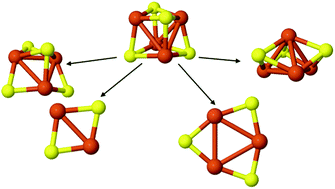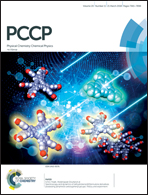Thermal stability of iron–sulfur clusters
Abstract
The thermal decomposition of free cationic iron–sulfur clusters FexSy+ (x = 0–7, y = 0–9) is investigated by collisional post-heating in the temperature range between 300 and 1000 K. With increasing temperature the preferential formation of stoichiometric FexSy+ (y = x) or near stoichiometric FexSy+ (y = x ± 1) clusters is observed. In particular, Fe4S4+ represents the most abundant product up to 600 K, Fe3S3+ and Fe3S2+ are preferably formed between 600 K and 800 K, and Fe2S2+ clearly dominates the cluster distribution above 800 K. These temperature dependent fragment distributions suggest a sequential fragmentation mechanism, which involves the loss of sulfur and iron atoms as well as FeS units, and indicate the particular stability of Fe2S2+. The potential fragmentation pathways are discussed based on first principles calculations and a mechanism involving the isomerization of the cluster prior to fragmentation is proposed. The fragmentation behavior of the iron–sulfur clusters is in marked contrast to the previously reported thermal dissociation of analogous iron-oxide clusters, which resulted in the release of O2 molecules only, without loss of metal atoms and without any tendency to form particular prominent and stable FexOy+ clusters at high temperatures.



 Please wait while we load your content...
Please wait while we load your content...